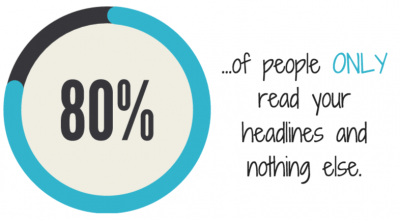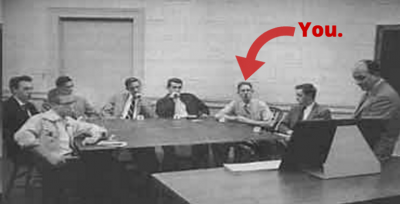Spoiler Alert: 8 out of 10 people only read the headline of whatever you put out.
Most people are shocked to hear this.
All that work you put into researching, writing, and rewriting. All the hours or days of effort. And 80% of your traffic gives nothing but a cursory glance at the headline and moves right along.
Ouch.
Become a Headline Writing Wizard
Because of this staggering stat, I have become obsessed with writing good headlines.
For blog articles… landing pages… email subject lines too, I agonize over my headline and do lots of testing to see what’s best.
The headline is the MOST IMPORTANT piece of copy you will write in your business.
Why?
The internet is packed with blog articles, videos, images, and other attention-worthy attractions.
Our headlines are the main shot we have to cut through the noise and get someone to go a little further. Just 2 out of 10 people stay and read the rest of the article.
If you are reading this very sentence, you are a member of the awesome 20%! #VirtualHigh5
Conversion Tests + Psychology = Headline Success
So we need to learn from sites like UpWorthy, Huffington Post, and Buzzfeed and companies like LeadPages and Click Funnels who are in the business of getting headlines on articles and landing pages right.
We need to apply principles from Psychology.
We need to write headlines that crush it.
So, let’s pull back the curtain on some tricks you can use right away for hotter headlines that convert by looking at 4 facts (or secrets ;)) from psychology, analyze real headline examples from sources like UpWorthy and HuffPo, and get you primed to apply these secrets to your own writing of irresistibly clicky headlines!
4 Secrets Revealed: Insights from Psychology to write headlines that convert
1. Visualization and mirror neurons are legit. (No ‘woo-woo’ stuff here).
The Psychology Principle at Work:
We humans live a lot ‘in our heads.’ Literally.
Here are two specifics to consider.
1. Visualization
More and more elite athletes and their coaches are tapping into Sports Psychology and harnessing the power of visualizing success on the track, on the field, or in the ring.
Imagining a positive outcome and all the scenarios that could arise help athletes perform better when the time does come to compete.
“…the successful golfer knows he must ‘see’ the ball going in the cup before he strokes it. The good hitter in baseball ‘sees’ the ball dropping in for a base hit before he swings at the ball, and the successful salesman ‘sees’ the customer buying before he makes the calls.” – Zig Ziglar
2. Mirror Neurons
Your friend comes in flushed and heart racing. He tells you a harrowing tale about being chased by gunmen and slamming his head into a low-hanging beam as he fled in escape.
As he tells the story, how do you feel?
I bet your heart picks up speed and your head throbs juuuust a little.

Those are mirror neurons at work.
What does this all mean?
We are wired to imagine things in our mind. And we even feel what others are feeling as we observe, read about, or hear about things that happen=.
“No man [or woman] is an island.”
– Creds for this go to: English poet John Donne, 1624
We are built to feel empathy and live vicariously through the words and actions of others.
Let’s Apply This to Headlines:
A wise and clever technique with your headlines then is to get the reader instantly engaged by triggering these principles at work.
Get them visualizing.
Get them putting themselves in the shoes of the person in the photo along with the advertisement. Use words that conjure up images your target audience resonates with and will paint a picture for them.
Real Headline Examples:
In the first example below, just seeing the words “tear-jerking” and “mom” in this headline instantly make me tear up. I am a softy, so maybe it has a stronger affect on me than others, but the principle remains true.
Eliciting emotion and writing so as to get the reader starting to visualize is darn effective.
As I read this below I imagine if my step-mom were gone and I discovered unopened messages from her. *tear* It makes me want to open this article and see what this guy Charles’ mom left behind for him.
Here in this second example, without even clicking through to see the turbines in action, I already start swaying side to side. Saying “Try not to ____” is an open invitation to do just that.
It’s like saying, “Don’t picture a pink elephant.”
Psychology at work!
Did you sway back and forth at all? 🙂 Admit it. 🙂
2. Conformity is not just for the spineless.
The Psychology Principle at Work:
If you’ve ever taken a psychology course, you have heard about the Asch Experiment (of 1951).
It goes something like this… imagine you volunteer to participate in an experiment on visual perception. You are ushered into a room with a large table and about 7 chairs. You sit down near the edge of one table where just a seat or two remain.
A researcher in a white coat or business suit enters and reveals lines drawn on the board at the front of the room. It looks something like this:
The researcher then explains that they are testing visual acuity and asks each person in the room one by one to identify which line A, B, or C is closest in length to the line at the left.
Person 1 says: B
- Person 2 says: B
- Person 3 says: B
- Person 4 says: B
- Person 5 says: B
- What do you say?
Turns out, you very likely would say B!
But it’s C…duh!
Yep.
But when in a situation like this we often go with the crowd assuming they have more information than we do or that somehow we are mistaken. Or at the very least we report the wrong answer just not to stand out in a ‘negative’ way.
In this experiment, everyone else in the experiment was actually a ‘confederate’ who was working with the researcher. The only true participant was you! And they were not testing perception, they were testing to see what you would say.
They were testing conformity. 🙂
Read more about the real Asch Experiment here. We humans conform at surprisingly higher rates than one would guess. A fact we should all keep in mind in day to day life. But lest I digress again…
Let’s Apply This to Headlines:
Simple. And you already know this. Use social proof!
I have seen websites say things like, “Join thousands of readers and subscribe to our email list.” Well, thousands of people can’t be wrong, maybe I need to jump on that list!
Or how about, “10 Things Social Media Experts Can’t Live Without”?
If you are a social media expert or want to improve your social media, now you gotta read this article to see what all the other ‘players’ in the industry support.
Real Headline Examples:
This first example below shows a picture of Russell Brandt and the headline plays on the exposure and popularity of celebrities (for a good cause, it happened to be).
Readers think, “Well, if celebrities are involved, it must be worth reading.”
Next, this headline below starts right off with “Experts Say” to get the reader thinking that something of value is being shared. Long story short, leverage social proof in your headlines.
Try out some headlines ripe for Upworthy and Huffington Post now (just plug and play). Don’t reinvent the wheel, use proven formulas that work.
3. Expectations and satisfaction are strongly linked.
The Psychology Principle at Work:
Have you ever heard the — kind of true — joke about how the solution to being happier is to ‘lower your expectations’?

Turns out, to a great degree, we like predictability and to know going in what we will find.
Sure, curiosity for what is left missing piques our interest (and could be an entire blog in and of itself), but you better deliver or over-deliver on what you entice me with or you lose credibility and I’ll bounce to watch cute cat videos.
Or I’ll refuse to watch another George Lucas film, depending on the circumstances.
Let’s Apply This to Headlines:
While I am not saying to toss creativity out the window with headlines, some of the most effective headlines still to date are ‘list’ articles.
- “Top 10 Social Media Tools: 4 of Which Are Free”
- “Sleeping: 5 Ways You’re Doing It Wrong”
- “9 Examples of Effective Headlines That Got 3x Increase in Subscribers”
By putting numbers in headlines, it gives our brains an anchor for what we can expect.
Then, when we read further and see the numbers laid out in a clear list — delivering on the promise! — we feel pleased and it builds trust.
Real Headline Examples:
Here are two examples from the Huffington Post. Both of which I want to click on. I love me some numbas!
Maybe it’s the former Math teacher in me.
4. We are all ego-centric.
The Psychology Principle at Work:
What is everyone’s favorite word … in any language?

We can’t help it. We see the world through our own eyes and our own perspectives.
Try as we might to fight it, we tend not to truly listen during conversations as we wait for our turn to talk and prepare our counterarguments while the other person wraps up.
We tend to gravitate toward others who look, speak, and act like ourselves or those we are most accustomed to (hence the vital importance of international travel to expand our ‘normal’ and world view).
Don’t get me wrong, we are amazingly kind, generous, and altruistic too! But we do have an ego-centric core.
And for good evolutionary reason!
Think to the caveman days when survival was far harder than it is today with a Starbucks and mega grocery store on every corner. You had to focus on protecting yourself first and your closest kin second, all others be damned. The struggle actually was real.
Let’s Apply This to Headlines:
Bring your audience in. Use language that gets them not only visualizing but putting themselves into the position of the ‘person’ speaking or acting.
Using the words “you” and “your” are great for this!
Take this study with different headlines for an e-commerce website as a great example:
A: “For sale: Black iPhone4 16GB” (the regular headline)
B: “Anyone need a new iPhone4?” (question headline without referencing cues)
C: “Is this your new iPhone4?” (question headline with self-referencing cues)
Researchers found that:
- question headlines (like B and C) performed better than statement headlines (like A)
- headlines with audience-referencing cues (like C) generated higher click-throughs than others.
Note: This does depend on the message being conveyed as well, so always be sure to test with your own niche and audience. (Source of study referenced)
Real Headline Example:
Here is an example of a headline that uses the word “your.”
It goes a step further and presupposes that you have family and self-doubt that get in the way of things in your life. This may not jive with everyone, but for the target audience, it cuts right to the core of them.
This is a great example of knowing your target, speaking to their center, and enticing their ego to want to click and read more.
Summary
To recap the lessons from psychology here as we analyzed examples from UpWorthy and the Huffington Post:
- Visualization and mirror neurons are legit:
Get your readers visualizing and imagining.
Get them picturing in their mind’s eye for increased engagement and chances for reading further. - Conformity is not just for the spineless:
As much as we don’t want to believe it, we are all influenced by what others around us are doing and saying.
Leverage that with social proof and words that show others have endorsed (directly or indirectly) what you are writing about in your headlines. - Expectations and satisfaction are strongly linked:
A great way to set expectations and deliver with your headlines is using numbers in them.
I’m a sucker for these. This post and the freebie I am giving away below both follow this pattern. I love numbers! - We are all ego-centric:
Not in a bad way, but we all see the world best through the eyes we have and the perceptions that affect our every judgment.
So write your headlines with “you” and “your” to get your reader even more connected and engaged with what you have to offer.
Sound off!
Here are some other headlines I brainstormed on for this article.
- Everything You Need to Know about Headlines [That Convert]… You Learned in Psych101
- 4 Things You Should’ve Learned in PSYCH101: To Write Headlines That Turn Heads
- The PSYCH101 Guide to Writing Head-Turning Headlines
- Write Clear & Enticing Headlines with These 4 Psychology Tips
- 4 Things You Forgot About Psychology That Make You a Better Copywriter
- Write Headlines like Upworthy or HuffPo: 4 Lessons from Psy101 You Shouldn’t Forget
- 4 Psychology Facts Every Marketer Should Know: Apply Them for Catchy Headlines
- Write Better Headlines: 4 Psychology Facts Every Marketer Should Know and Apply
Ping me on Twitter @LaptopLaura and tell me how YOU would title this article!
If you create a better one, I will change the title (after a wee bit ‘o testing) and give you cred! #Respect!






 Person 1 says: B
Person 1 says: B



